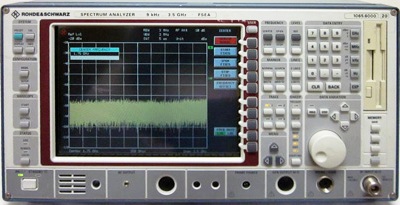
|
|
The Rohde & Schwarz FSEA 20 (1065.6000.25) 3.5 GHz Spectrum Analyzer has been optimized both for general-purpose measurements and meeting the stringent requirements of testing advanced digital communication systems. The FSEA 20 combines the capabilities of high-end RF or microwave spectrum analysis with those of universal digital-signal demodulation and analysis. This becomes possible with the vector signal analyzer option. The spectrum analyzer function offers the wide dynamic range necessary for many measurements on digitally modulated signals (e.g. burst measurements), and the vector signal analyzer option adds demodulation capability to bit stream level for signals such as – BPSK, QPSK, pi/4-DQPSK and 16QAM, (G)MSK, (G)FSK. FSEA 20 features a minimum full-span sweep time of 5 ms with a fully synchronized sweep. This means that added speed is not at the expense of frequency accuracy but even enhances it. The shortest zero-span sweep time is 1 µs (100 ns/div) – ideal for high-resolution measurements on pulse edges. Up to 25 sweeps per second is an optimal prerequisite for rapid and easy alignments and for applications in production. Specifications. Frequency range: 9 kHz to 3.5 GHz. Frequency resolution: 0.01 Hz. Resolution bandwidths: 10 Hz to 10 MHz, 3-dB bandwidths (in 1/2/3/5 steps). Max. dynamic range bandwidth: 10 Hz. Displayed noise floor to 1-dB compression:155 dB. 3rd-order intermodulation., intermodulation-free dynamic range, level 2 x –20 dBm, delta-f >5 x RBW or 10 kHz, whichever is the greater value: >64 dBc for f >50 MHz (T.O.I. >12 dBm, typ. 18 dBm). 1-dB compression of input mixer: +10 dBm nominal (0-dB RF attenuation). Phase noise at 10 kHz from carrier: < -95 dBc / Hz. Sweep time Span = 0 Hz: 1 us to 2500 s in 5% steps. Display: 24 cm LC TFT colour display (9.5"). IEC/IEEE-bus control interface to IEC625-2 (IEEE 488.2), command set: SCPI 1994.0. Options. FSE-B2, 7-GHz Frequency Extension. FSE-B4, Low Phase Noise and OCXO. FSE-B5, FFT Filter. FSE-B7, Vector Signal Analyzer. FSE-B8, Tracking Generator 3.5 GHz. FSE-B9, Tracking Generator 3.5 GHz with I/Q modulator. FSE-B12, Switchable Attenuator for Tracking Generator. FSE-B13, 1 dB Attenuator. FSE-B15, Controller for FSE (mouse and keyboard included). FSE-B16, Ethernet Interface. FSE-B17, 2nd IEC/IEEE-Bus Interface for FSE. FSE-B18, Removable Hard Disk. FSE-B19, 2nd Hard Disk for FSE-B18 (firmware included). FSE-B21, External Mixing. FSE-B22, Increased Level Accuracy up to 2 GHz. FSE-B23, Broadband Output 741.4 MHz. FS-K3, Noise Measurement Software, Windows. FS-K4, Phase Noise Measurement Software, Windows. FSE-K10, GSM Application Firmware Mobile station. FSE-K11, GSM Application Firmware Base station.
|